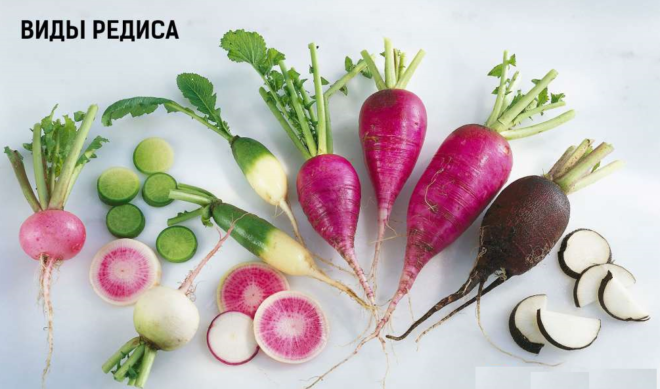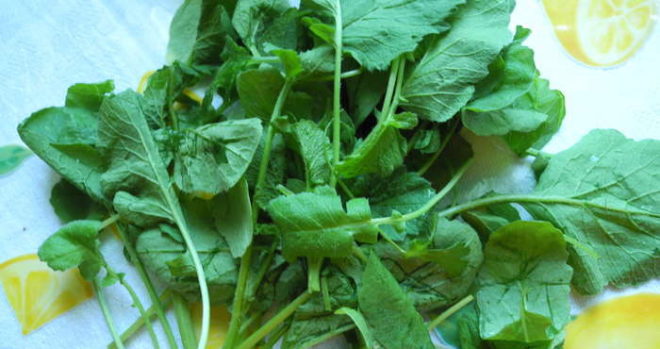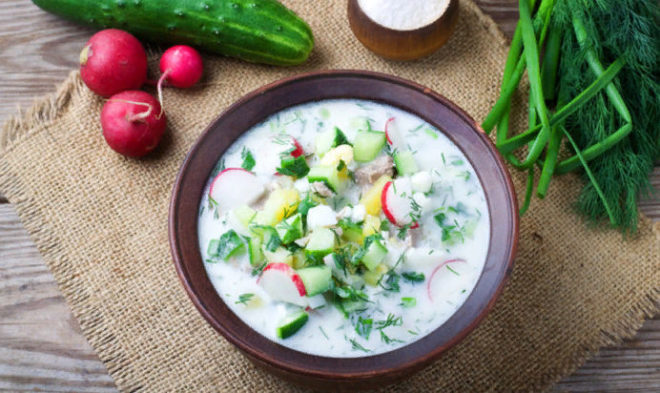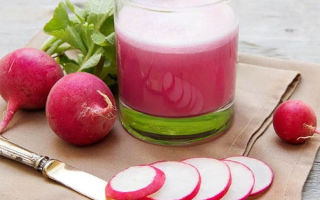Content
- 1 What is this vegetable
- 2 Composition and calorie content of radish
- 3 Useful properties of radishes
- 4 The benefits of radish for women
- 5 The benefits of radishes for men
- 6 Can radishes for children, and at what age
- 7 Is radish good for weight loss?
- 8 Radish consumption rates
- 9 What does radish treat
- 10 Traditional medicine recipes
- 11 Useful properties of radish tops
- 12 The use of radish in cosmetology
- 13 What can be made from radishes
- 14 How to remove bitterness from radishes
- 15 How to store radishes
- 16 Harm of radish and contraindications
- 17 Conclusion
The benefits of radishes are beyond doubt, although many people do not know what exactly this vegetable gives to the body. The benefits and harms of radishes have been known since ancient times. It is used in folk medicine, and in cosmetology, as well as a delicious vegetable in salads. But, like any food, you should not abuse radishes, so as not to harm your health. This is especially true for people with contraindications for the use of such vegetables in large quantities.
What is this vegetable
Radish is a variety of the well-known sowing radish. The vegetable became known to mankind 3 thousand years ago. In Europe, the vegetable has been grown since the 15th century. It is a root vegetable with elongated or rounded fruits and green leaves. Its characteristic spicy taste is known to many.
Radish appears on the table in early spring, but it can be grown all year round both in the open field and on a windowsill or in a greenhouse.

Composition and calorie content of radish
The product contains a huge amount of vitamins, micro and macro elements. At the same time, the vegetable is low in calories, which allows it to be consumed with any diet. The radish contains:
- Thiamin.
- Riboflavin.
- A nicotinic acid.
In 100 grams of radish:
- Water - 93 g.
- Dietary fiber - 1.6 g.
- Proteins - 1.2 g.
- Fat - 0.1 g.
- Carbohydrates - 3.4 g.
Mustard oils give the radish its characteristic flavor. At the same time, the calorie content is only 11 kcal per 100 grams of product.
What vitamins are in radishes
Particular attention should be paid to the vitamins that are found in radishes. This is a storehouse of nutrients. The large amount of B vitamins make this root vegetable an indispensable vegetable in the daily human diet. Only vitamin B12 is missing from this list. In addition, it contains vitamins PP, C and vitamin E. The daily requirement for vitamin C is covered by only 200 grams of radish.
Useful properties of radishes
The vegetable has the following beneficial properties:
- Lowers blood glucose levels.
- Restores acid-base balance in the blood.
- Stops the growth and development of oncology.
- Prevents the development of colon cancer.
- It has a choleretic effect.
- Reduces irritation of the gastrointestinal tract receptors.
- Strengthens the immune system.
- Diuretic, the vegetable is effective for edema.
- Reduces weight.
- Eliminates anemia and restores normal blood formation.
- Helps with dry coughs and many colds.
- Improves skin and complexion color.
- Removes toxins, cleanses the intestines.
This is an incomplete list. Moreover, they use radishes not only inside, but also in the form of masks and decoctions.

The benefits of radish for women
For the weaker sex, radishes are no less useful than for men. Since ancient times, women have been using this vegetable in a crushed state in cosmetology. In nutrition, radishes are useful as prevention of breast cancer.The anti-aging properties of radish have also been known for a long time, and therefore every woman should eat this root vegetable. Radish contains folic acid, which is considered an exclusively female vitamin and is responsible for the proper development of the fetus in early pregnancy.
Can a radish be pregnant
During pregnancy, it is necessary to consume radishes. First of all, because of the fiber, which normalizes the intestines. This problem often plagues pregnant women. They suffer from constipation, and you cannot take a laxative, since you can harm the child.
A large amount of vitamins and the early appearance of an irreplaceable vegetable on the shelves make radishes indispensable for women in the position. But there are also contraindications. Experts recommend to consume the vegetable only stewed or processed warm during pregnancy. Then the benefits of radishes for a woman's body will not be overshadowed by harm.
Radish when breastfeeding
When breastfeeding, the mother carefully chooses her diet, since her diet directly affects the baby's digestive tract. For this reason, doctors do not recommend radishes for breastfeeding. This vegetable can cause colic, bloating, and bowel problems in an infant. It is necessary to completely eliminate radishes from the diet until the baby reaches 3 months. Then you can, but on the advice of a pediatrician.
The benefits of radishes for men
Since men are statistically more susceptible to cardiovascular diseases than women, salads with radishes should become a must-have item on the menu for them. Vegetable helps to remove cholesterol from the body, and therefore cleanses and strengthens blood vessels. Diabetes mellitus is an excellent product for lowering sugar.
The vegetable helps a lot of working men to avoid constant fatigue and chronic stress, therefore, it helps to maintain normal potency for many years of life.
Can radishes for children, and at what age
A large amount of vitamins and trace elements makes this root vegetable indispensable for the child's body.

Since the root vegetable has a pungent taste, not all children eat it with pleasure. Therefore, it is better to give it in small quantities and in salads, not in pure form. Acquaintance with radish should take place at 2 years old. The earliest is at 1 year and 6 months, but only after consulting a pediatrician and if the child does not have food allergies and gastrointestinal problems.
A three-year-old child can be offered 40 grams of radish at one meal, then gradually increase the dose, focusing on the well-being and desires of your child. It is not difficult to say how useful radish is. For a child, radishes are useful because it raises the appetite and is perfect as a snack if the child does not eat very well. Radish strengthens baby's hair, nails and teeth.
Is radish good for weight loss?
Radish is used in many diets as an essential weight loss vegetable. The root vegetable has an important property - it helps to break down fats, which has a positive effect on weight and health. The product can be used both as a separate diet for weight loss and in various salads and other culinary recipes.
If you eat radishes twice a week for a month, then an extra 2-3 kg will go away. One of the slimming recipes is a fresh radish salad with chopped green apple and lemon juice.
Radish consumption rates
First of all, nutritionists advise against consuming radishes every day, as it can cause intestinal discomfort. It is also not recommended to eat the root vegetable on an empty stomach, since mustard oils can cause severe burns of the mucous membrane. Up to 300 grams of radish per day is considered a safe norm.
What does radish treat
The main diseases in which radish is successfully used:
- Oncology, including rectal cancer.
- Constipation.
- Diabetes.
- Stress.
- Gastrointestinal problems.
- Hepatitis.
- Anemia.
- Depression.
- Sleep disturbances.
In addition, radishes strengthen muscles and stimulate the brain.
Traditional medicine recipes
Radish has been used in folk medicine for more than one generation. Here are some recipes:
- From sciatica. You need to take several root vegetables and grind them thoroughly. Put everything that happened on cheesecloth and attach to a sore spot on the lower back.
- For immunity. For 200 grams of radish, you need to take 100 grams of parsley (herbs) and 10 grams of honey. Mix everything. Add a couple of drops of lemon juice. Keep the mixture in the refrigerator. Eat a teaspoon twice a day on an empty stomach.
- With diarrhea. In 200 grams of cold milk add six crushed radish roots and 1 teaspoon of starch. You may have to repeat it in four hours.
Useful properties of radish tops
Radish tops are just as useful as the root crop itself. It can be added to any dish. The tops contain all B vitamins, as well as A, C, nicotinic acid and K. In addition to nicotinic, there is ascorbic acid and salicylic acid. Trace elements: iodine, lithium, zinc, cobalt.

It is useful for the prevention of rickets, strengthening the immune system, weight loss. Therefore, the answer to the question whether it is possible to eat radish tops is unambiguous - it is necessary.
Folk recipes for tops:
- Feet suffering from fungus, it is recommended to sprinkle powder from dried tops. The course is 7 days.
- From rickets. Mix ten leaves with cottage cheese (100 grams). Eat with sour cream every day.
Infusion of radish tops
Infusion of radish tops helps with many diseases. First of all, it is used for constipation. Recipe: pour 1 tablespoon of chopped leaves with a glass of boiling water. Insist for an hour, then strain and consume 20 minutes after meals three times a day.
Radish leaf juice
Freshly squeezed juice of radish and its tops is also useful for health. In folk medicine, leaf juice is used:
- With bronchial asthma.
- For bronchitis and colds.
- For problems with urination.
- With angina.
- For anemia and for its prevention.
In addition, it is an excellent remedy for vitamin deficiency.

The use of radish in cosmetology
In cosmetology, radish is used to whiten, soften the skin and cleanse the face. In addition, masks from this root vegetable can heal the skin and saturate it with vitamins.
Radish face masks
Whitening mask: mix 15 grams of root vegetables and the same amount of cucumber with a spoonful of sour cream. Apply to face for 15 minutes. Wash off with cool water.
Softening mask: grate radish and mix with melted butter. Keep on face for 20 minutes. Wash with warm water.
Hair radish
Radish is used to strengthen hair. To do this, squeeze the juice from the radish grated on a fine grater and rub it into the scalp.
What can be made from radishes
The use of this root vegetable in cooking is very diverse. You can make salads from it, but the most common dish is okroshka.

In addition, the product perfectly tolerates heat treatment, and therefore it can be stewed, boiled, fried. A very tasty dish - stuffed with radish with cheese or minced meat.
How to remove bitterness from radishes
The sharp taste of the root vegetable is not to everyone's liking. This is especially true for children. The first method is soaking. Add a tablespoon of salt to two liters of water. Put the radish in this solution for half an hour.
The second way is to use sour cream radish. This is especially true in salads.
How to store radishes
It is better not to store fresh root vegetables for a long time. If it becomes necessary, then it should be stored in the refrigerator. The shelf life of a vegetable with leaves is 4 days, if you cut them - 14 days.
Harm of radish and contraindications
The benefits and harms of radish for the body depends on the presence of chronic diseases and the amount of vegetables consumed. The first and main contraindication is the presence of an allergic reaction. Radish allergy occurs in a small number of people. And also radish can irritate the mucous membranes of the gastrointestinal tract, and therefore it is not recommended to eat it in large quantities for people with gastritis and ulcers. A doctor should be consulted if the patient has problems with the liver, pancreas and duodenum. You can not use radishes for some pathologies of the gallbladder.
The main benefits of the root vegetable are described here
Conclusion
The benefits of radish leaves, as well as the main root vegetable, in a large amount of vitamins and minerals. This is one of the first spring vegetables that appears on the table of gardeners and in the markets. You can use the beneficial properties not only in diets, but also for skin care. There are few contraindications, even pregnant women can eat salads with this vegetable. The benefits of fresh radishes are undeniable, but some people dislike its bitter taste.


